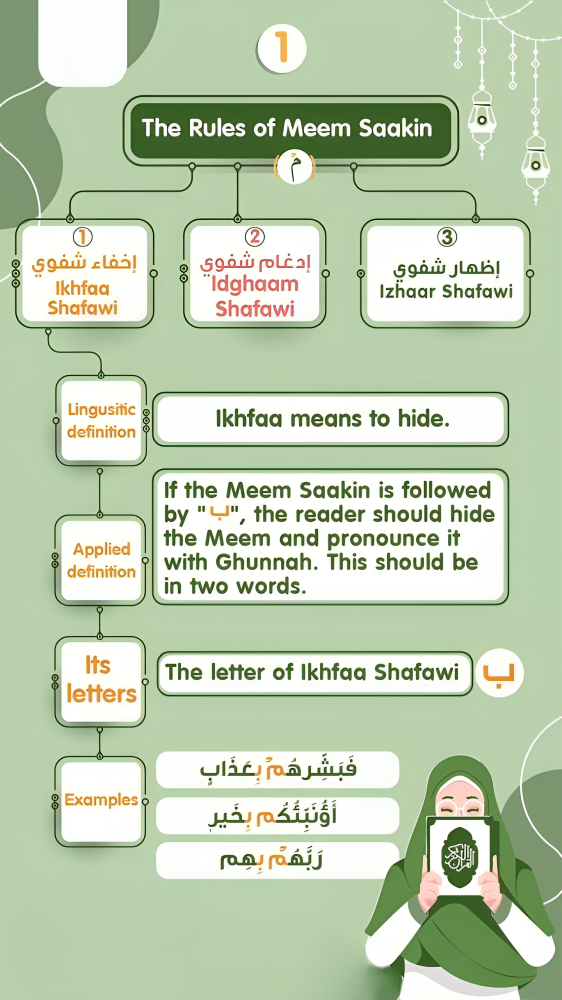Understanding Noon Mushaddad, Noon Saakin, and Tanween in Tajweed
In this lesson, we will explore the rules related to Noon Mushaddad, Noon Saakin, and Tanween in Tajweed. Correct pronunciation of these elements is essential for accurate Quran recitation. This lesson explains the four primary rules governing these letters and sounds, with practical examples from the Quran.
1. Noon Mushaddad (نّ)
Noon Mushaddad refers to the letter Noon (ن) with Tashdeed ( ّ ) on it. When Noon has Tashdeed, it is always pronounced with Ghunna (nasal sound). Ghunna involves using the nose to extend the sound of Noon.
- Example from the Quran:
إِنَّ
In this word, Noon has Tashdeed, so Ghunna is applied.
2. Noon Saakin (نْ)
Noon Saakin refers to the letter Noon (ن) with Sukoon ( ْ ) on it. A Sukoon indicates that the letter should be pronounced without any vowel sound. The sound stops at Noon.
3. Tanween (ًٌٍ)
Tanween refers to the double vowel signs:
- Double Fathah ( ً ),
- Double Kasrah ( ٍ ),
- Double Dammah ( ٌ ).
These symbols are placed at the end of a word and indicate an “n” sound, similar to Noon Saakin.
Four Rules for Noon Saakin and Tanween in Tajweed
The pronunciation of Noon Saakin and Tanween depends on the letters that follow them. There are four key rules that apply:
- Izhaar
- Idghaam
- Iqlab
- Ikhfaa
1. Izhaar (إظهار)
Izhaar means to pronounce clearly. If Noon Saakin or Tanween is followed by any of the six guttural letters (أ, ہ, ع, ح, غ,خ), the Noon or Tanween will be pronounced clearly, without Ghunna. This is known as Izhaar.
- Example from the Quran:
مَنْ آمَنَ
In this example, Noon Saakin is followed by the guttural letter Alif. Therefore, the Noon is pronounced clearly without Ghunna.
2. Idghaam (إدغام)
Idghaam means merging. When Noon Saakin or Tanween is followed by one of the Idghaam letters (ي, ر, م, ل, و, ن), the Noon or Tanween will be merged into the following letter. There are two types of Idghaam:
- Idghaam with Ghunna (nasal sound)
- Idghaam without Ghunna (no nasal sound)
Idghaam with Ghunna
If the Noon Saakin or Tanween is followed by the letters ي, ن, م, و, then the sound will be merged and pronounced with Ghunna.
- Example from the Quran:
مَنْ يَقُولُ
In this example, Noon Saakin is followed by Ya, and Idghaam with Ghunna is applied.
Idghaam without Ghunna
If the Noon Saakin or Tanween is followed by the letters ل or ر, the sound will be merged but pronounced without Ghunna.
- Example from the Quran:
مِنْ لَدُنْ
Here, Noon Saakin is followed by Lam, so Idghaam without Ghunna is applied.
3. Iqlab (إقلاب)
Iqlab means to change. If Noon Saakin or Tanween is followed by the letter Ba (ب), the Noon or Tanween sound will change to a Meem (م) sound and be pronounced with Ghunna.
- Example from the Quran:
أَنْبَأَهُمْ
In this example, Noon Saakin is followed by Ba, and the Noon sound changes to a Meem with Ghunna.
4. Ikhfaa (إخفاء)
Ikhfaa means to hide or conceal the sound. If Noon Saakin or Tanween is followed by one of the fifteen letters of Ikhfaa (ت, ث, ج, د, ذ, ز, س, ش, ص, ض, ط, ظ, ف, ق, ك), the Noon or Tanween sound will be pronounced lightly, with Ghunna, and partially concealed.
- Example from the Quran:
مِنْكُمْ
In this example, Noon Saakin is followed by Kaaf, and Ikhfaa with Ghunna is applied.
Conclusion
Understanding and applying the rules of Noon Mushaddad, Noon Saakin, and Tanween is vital for proper Quranic recitation. Whether it’s the clear pronunciation of Izhaar, the merging of sounds in Idghaam, the transformation in Iqlab, or the subtle concealment in Ikhfaa, these rules are fundamental to reciting the Quran with accuracy and beauty. Master these rules through regular practice and listening to proficient reciters for improved fluency in Quran recitation.





